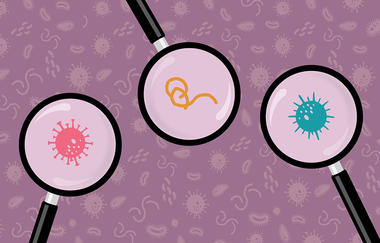
Key Findings
The novel coronavirus or COVID-19 pandemic has created a global health emergency and a punishing economic downturn. U.S. politicians at the federal, state, and local levels have been forced to take unprecedented actions affecting the everyday lives of Americans in all 50 states. As businesses and schools have closed, Americans have been asked to take extraordinary measures, including isolating themselves from friends and families in order to prevent the virus from spreading so quickly that it overwhelms the health care system.
Understanding the public’s response to the pandemic is therefore crucial. The public’s willingness to take personal steps and to support broader policies that limit the virus’s spread have influenced and will continue to influence the severity of the pandemic.
We argue that the public’s reaction to not only the coronavirus but also the most recent outbreaks of the Ebola and Zika viruses depends on the interaction of biology and politics. The public’s response depends on biology because people vary in their general fear of contamination — or their disgust sensitivity. People with a greater instinctual revulsion to situations that risk exposing them to a pathogen are more willing to take steps like social distancing or support policies that enforce such distancing or that guard the country’s borders from travelers who might carry an infection. Despite important differences between the Ebola, Zika, and coronavirus outbreaks, we show that disgust sensitivity is linked to attitudes in each case.
But the political contours of attitudes in these outbreaks are quite different. In particular, Democrats and Republicans have viewed these outbreaks in different ways. For example, Republicans were more concerned about the Ebola outbreak than were Democrats. The reverse is true for the coronavirus outbreak. Moreover, partisan differences in views on the coronavirus have sharpened over time. Although majorities of both parties report social distancing and support restrictions such as closing businesses or limiting non-essential travel, fewer people, and especially fewer Republicans, now support these actions. This shift is most pronounced among Republicans who pay attention to politics, suggesting that they are responding to the rhetoric of the GOP party leaders who have called for a “re-opening” of the country.
The future of the virus will depend on how these politics play out.
As the nation grapples with this new pandemic, there are lessons we can learn from the past. Two recent epidemics, Ebola and Zika, received considerable attention in the U.S., although they differed from the novel coronavirus pandemic in significant ways.
The first is in the spread and severity of the diseases: COVID-19 was officially designated a pandemic — a global outbreak — by the World Health Organization in March 2020, while the 2014–2016 outbreak of Ebola and the 2016 outbreak of Zika each were considered epidemics — that is, geographically confined public health emergencies of international concern. Only four cases of Ebola were diagnosed in the United States: Three were in a Dallas hospital and one in a New York City hospital. At the height of the 2016 Zika outbreak, 5,168 positive cases were reported: About 4,900 were travelers returning from affected areas, and the rest were domestic cases that involved transmission through mosquito bites or sexual contact. At the time of this writing, however, there are 3 million confirmed cases of the novel coronavirus and over 130,000 COVID-19 deaths in the U.S.
The severity of the coronavirus pandemic is visible in the public’s level of concern about it. For example, as of a May 23–26, 2020, YouGov/Economist poll, 45 percent of respondents say they are “very concerned about the coronavirus epidemic here in the United States,” and 34 percent say they are somewhat concerned. Twenty-one percent say they are not too or not at all concerned. By contrast, according to YouGov polls conducted in the midst of the Ebola and Zika epidemics, the fraction of respondents who were very concerned was only 21 percent and 20 percent, respectively.
Table 1
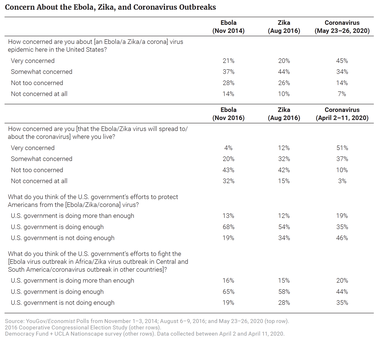
A similar pattern emerges when people were asked about their concern about these viruses “where you live.” As of April 2020, many more are concerned about coronavirus “where they live” than were concerned about either Ebola and Zika in 2016 — although it’s important to note that the survey was conducted about two years after the peak of concern about Ebola in the U.S. (however, the outbreak continued to affect African countries during those years). Likewise, fewer Americans think the government is doing enough to address the coronavirus, either in the U.S. or in other countries, compared to sentiments expressed earlier in response to the Ebola or Zika virus. In part, this is because a slightly larger percentage of Americans think that the U.S. government is doing more than enough on the coronavirus. But more important, a much larger percentage believe that the government is not doing enough to fight the coronavirus in the U.S. or abroad.
Given that all three of these outbreaks originated outside of the United States, each of them raised questions about how to reduce the risk that infected people would enter the country. In both 2016 and 2020, Americans were asked about three policy options ranging in their restrictiveness and they were randomly assigned to consider U.S. citizens returning to the country or the entry of foreign citizens.
Table 2
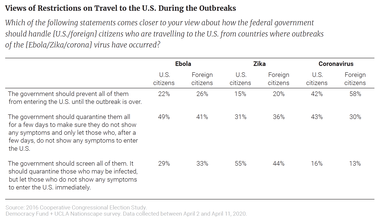
Americans take a harder line on preventing U.S. citizens from returning home during the coronavirus outbreak compared to their response to either the Ebola or Zika outbreaks. For example, 42 percent favor preventing U.S. citizens from entering until the coronavirus outbreak is over. By contrast, in 2016 only 22 percent favored this option as a response to the Ebola virus and 15 percent favored it as a response to the Zika virus.
Americans are also more likely to favor keeping out foreign citizens than they are U.S. citizens. This was the case during the Ebola and Zika outbreaks, and support for restrictions against foreign citizens is even higher during the coronavirus outbreak. More than half of Americans (58 percent) favor preventing foreign citizens from entering the country until the coronavirus outbreak is over, compared to the 42 percent who want to prevent U.S. citizens from entering.
The coronavirus and political rhetoric surrounding it appear to have made concerns about foreign citizens particularly salient. The difference in opinions about foreign and U.S. citizens — a 16-percentage-point gap — is notably larger with regard to the coronavirus outbreak than with the earlier outbreaks. And although rhetoric focusing on foreign citizens — such as references to the “Wuhan virus” and “kung flu” — has been particularly common among some Republican leaders, including President Donald Trump, both Democrats and Republicans are more likely to favor preventing entry by foreign citizens than by U.S. citizens.(1)
(1) Among Democrats, 38 percent favor preventing all U.S. citizens from entering the country, and 52 percent favor preventing foreign citizens from entering. Among Republicans, the comparable percentages are 48 percent and 67 percent.
Public attitudes about epidemics are shaped by human biology, and particularly by one key trait: the emotion of disgust. According to one prominent account, human beings developed disgust especially to help them avoid pathogens. Disgust is essentially a “disease-avoidance mechanism.”(i) Political science research has shown that disgust is related to views of food safety regulation, homelessness, health policy, and immigration.
Societies around the world have identified foods, practices, and peoples that elicit the emotion of disgust and its accompanying avoidance behaviors. Although disgust is nearly universally present in societies, the target of disgust is culturally constructed; what is disgusting in one society may not be in another. Moreover, individuals within a given society vary in how sensitive they are to feeling disgust, and research has shown that this disgust sensitivity influences their support for governmental policies that protect the individual and society from contamination.(ii)
Research has already shown that disgust sensitivity — in particular, concern about the potential of contamination — was related to views of the Ebola and Zika epidemics. People who were more sensitive to the risk of contamination were more concerned about those epidemics and more likely to favor stricter government policies to protect the country.(iii)
Disgust sensitivity should also be related to concern about the current pandemic, and perhaps even more than it was for concern about Ebola and Zika. Ebola is highly contagious and life-threatening, but it does not spread as rapidly as some viruses because it requires contact with the bodily fluids of symptomatic individuals. Zika has generally mild symptoms, is rarely life-threatening, and is spread mostly through mosquito bites and less commonly through sexual contact and blood transfusion, not from casual human-to-human contact.(2)
The novel coronavirus, by contrast, appears to be highly contagious, is transmitted by casual contact with both symptomatic and asymptomatic carriers, and can lead to a broad range of symptoms, from mild to life-threatening. This combination of contagiousness and casual transmission may heighten the importance of disgust sensitivity. At the same time, disgust sensitivity may do less to shape opinions on the current pandemic because the virus poses a widespread and realistic threat to many Americans, most of whom are already on alert.
Disgust sensitivity is typically measured by asking people to indicate how much they seek to avoid contamination or recoil from behaviors that evoke contamination. For example, one commonly used question asks respondents how much they agree with the statement “I probably would not go to my favorite restaurant if I found out that the cook had a cold.”
In the April 2–11, 2020 Democracy Fund + UCLA Nationscape™ survey, 57 percent agree with this. Another question asked people how disgusted they would be if they drank from the glass of a friend by mistake. Twenty-five percent say that they would find it to be very or extremely disgusting. (See Appendix Table A-1 for more detail.)
Unsurprisingly, disgust sensitivity registers a bit higher now than it did in surveys conducted in 2012 or 2016 based on responses to these two questions, which describe contexts that could plausibly transmit the coronavirus. However, responses to the two other questions used to measure disgust sensitivity were stable.(3)
Moreover, the personal characteristics associated with disgust sensitivity are similar at all three points in time. In surveys conducted in 2012 and 2016 and in the April 2020 Nationscape survey, disgust sensitivity is higher among women compared to men and among racial minorities compared to whites. Although disgust sensitivity was higher among those who identified as conservative in the 2016 survey, it was not in the 2012 survey nor in the April 2020 Nationscape survey. And in none of these surveys was disgust sensitivity related to party identification. It is not systematically higher or lower among Republicans or Democrats. This makes it easy to disentangle any effects of disgust sensitivity on attitudes toward the coronavirus from the effects of party identification.
In surveys about Ebola and Zika conducted in 2016 and in the April 2020 Nationscape survey, views of these epidemics were linked to disgust sensitivity (Figure 1).(4) Americans who were more prone to feeling disgust were also more concerned about each epidemic and, in the case of Zika and Ebola, more likely to believe that the government was not doing enough to fight the epidemic in the U.S. and abroad. Americans prone to disgust were also much more likely to want to prevent both foreign citizens and U.S. citizens from entering the U.S. at all. Disgust sensitivity was not related to views of the government’s handling of coronavirus — a finding likely attributable to the powerful effect of partisanship in the current highly-polarized context.
(2) A Zika infection during pregnancy can also lead to fetal microcephaly.
(3) We present results using a scale built from all four questions, but the results are substantively similar if we employ a scale built from only the two questions where responses have been stable in the aggregate since 2016.
(4) This finding is based on statistical models that include disgust sensitivity and other factors, including party identification, self-identified ideology on the liberal-conservative scale, race, gender, and age. See Appendix Table A-2 for model results. These results are virtually unchanged by adding county-level measures of urban-rural status or county-level measures of coronavirus infections or deaths.
Figure 1
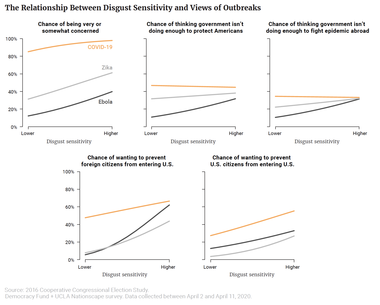
Much of what the public knows about public health threats comes from the news media and political leaders. As a result, partisanship invariably shapes Americans’ understanding, especially when political elites are divided. If leaders of both parties agreed that a virus posed a significant threat, then there would be few partisan divides among voters. But if leaders clearly disagreed, then one party’s voters would be more concerned about the virus than the other party’s voters.(5)
During the Ebola epidemic, there was a clear partisan divide among political leaders. Republican leaders talked more frequently and expressed more concern about the epidemic, for example. But this stopped soon after the midterm election in 2014.(iv)
During the Zika epidemic, much of the media coverage focused on how the virus might affect the Olympics in Rio de Janeiro as well as its implications for pregnant women. President Obama requested emergency funding to address the epidemic, and ultimately Congress approved $1.1 billion. Political skirmishes between Democrats and Republicans focused on attempts to attach provisions to the funding bill that would defund Planned Parenthood. But overall, it received significantly less coverage than Ebola did.(v)
During the coronavirus pandemic, the central variable has been Trump himself, who has shifted from downplaying the significance of the virus, to adopting a more somber tone and warning of the virus’s consequences, to declaring that the virus’s consequences are less serious than predicted and advocating for relaxing restrictions intended to enforce social distancing. Democratic leaders, meanwhile, have more consistently warned of the virus’s consequences and favored stricter provisions.
The impact of partisan messages is visible in polls asking people how concerned they were or are about each outbreak (Figure 2). In 2014, the percent somewhat or very concerned about the Ebola epidemic dropped during the fall as the threat to the U.S. appeared to fade. But Republicans were always more concerned than Democrats, matching the rhetoric of party leaders. During the spring and summer of 2016, there were only modest and inconsistent partisan gaps in concern about Zika.
The story of the coronavirus has been different. Throughout the outbreak, Democratic concern has exceeded Republican concern. But the divide between the parties has varied. The divide widened in late February and early March. The percentage of Republicans concerned about the virus fell from 68 percent in a February 16–18 YouGov/Economist poll to 52 percent in a March 8–10 poll. This coincides with a period in which Trump expressed little concern about the virus. He said that the situation was “very much under control” (on February 23 and 24), the number of cases “is going to be down close to zero” (on February 26), the virus will “disappear…like a miracle” (on February 27), “everything is really under control” (on February 29), it’s “very safe to fly” (on March 4), and “anybody that wants a test can get a test” (on March 6). On March 10, he said, “Just stay calm. It will go away.”(vi)
But then on March 11, Trump announced travel restrictions from Europe. On March 13, he declared a national emergency. On March 16, he announced social distancing guidelines and said he had told his son that “it’s bad.” Trump’s statements in this period were not uniformly so somber, but the change was evident both in his rhetoric and the reaction of Republicans in the electorate. Among Republicans, concern began to increase and the gap between Democrats and Republicans narrowed. Republican concern peaked in an April 5–7 poll, which was fielded soon after Trump’s March 31 statements that “this could be a hell of a bad two weeks” and that the virus was “vicious.”(vii)
(5) This is a central insight from John Zaller’s work on public opinion formation (The Nature and Origins of Mass Opinion, 1992, New York: Cambridge University Press).
Figure 2
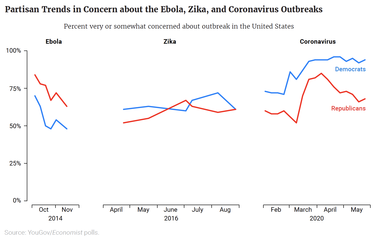
Since that point, however, Trump’s statements and those of other Republican leaders have shifted again, emphasizing that the number of coronavirus deaths has fallen short of some projections and that it is time to “reopen” the country. The percentage of Republicans concerned about the virus has fallen to 68 percent in a May 23–26 YouGov/Economist poll.
The impact of partisanship is visible in other types of attitudes about the coronavirus (Figure 3).(6) For example, when asked whether the government was doing enough to fight the coronavirus pandemic in the April Nationscape survey, Democrats were more likely than Republicans to say that the government was not doing enough both in the U.S. and abroad. Democrats in the electorate were likely taking their cues from Democratic leaders, who were and are criticizing the Trump administration for not responding quickly to the pandemic and for minimizing its importance. By contrast, Republicans and Democrats did not differ as much on whether the government was doing enough to fight the Ebola or Zika epidemics.
When asked about preventing foreign citizens and U.S. citizens from traveling to the U.S. during the coronavirus outbreak, it is Republicans, not Democrats, who are more supportive. This also reflects the positions of party leaders — and in particular how much Trump himself has advocated for restrictions on immigration generally, and as a measure to combat the virus. Trump has emphasized restrictions on travelers from China specifically. Again, Republicans and Democrats differed much less on this policy when focused on the Ebola and Zika epidemics.
(6) The graphs in Figure 3 are based on statistical models that include disgust sensitivity and other factors, including party identification, self-identified ideology on the liberal-conservative scale, race, gender, and age. See Appendix Table A-2 for model results.
Figure 3
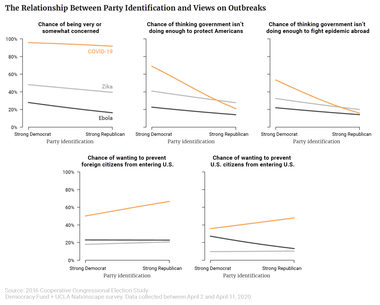
In the coronavirus pandemic, the importance of disgust sensitivity and partisanship extend even further. Both factors are related to Americans’ willingness to engage in behaviors that protect themselves and others from infection, as well as to Americans’ support for federal, state, and local measures intended to mitigate the outbreak’s impact on public health and the economy.
Overall, large majorities of Americans report that they are taking personal steps to reduce the risk of infection — including wearing a mask when going out in public as well as other measures of social distancing (Table 3).
Table 3
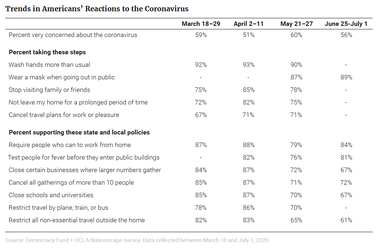
Majorities also support the restrictions imposed by many states and localities, including those that close businesses, prohibit large gatherings, and take other steps to reduce interpersonal contact and increase social distancing. In recent weeks, support has fallen, however. For example, the percent in support of restricting non-essential travel has fallen to 61 percent as of late June. (However, it was even lower in the three prior weekly surveys, suggesting that the increasing number of cases is leading at least some people to support restrictions again.)
Although majorities of Americans continue to favor social distancing efforts, clearly support is not universal. In particular, it is related to disgust sensitivity. In the April 2–11 Nationscape survey, which included a measure of disgust sensitivity, support was higher among those who are more prone to disgust, even after accounting for partisanship and other factors (Figure 4).(7) These people were more likely to say that they were washing their hands more, avoiding gatherings, staying home, and so on. And although support for state and local restrictions on travel and social contact was high, support was modestly lower among those with less disgust.
(7) These estimates are also based on statistical models that also account for party identification, self-identified ideology on the liberal-conservative scale, race, gender, and age. See Appendix Table A-3.
Figure 4
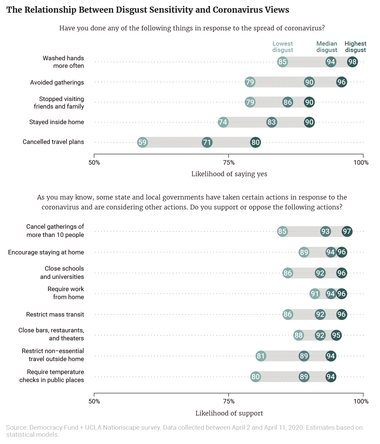
People’s political attitudes have also become increasingly related to partisanship. Compared to Democrats, Republicans have become less concerned about the coronavirus and less likely to support state and local restrictions such as closing businesses and restricting nonessential travel (Figure 5).
Figure 5
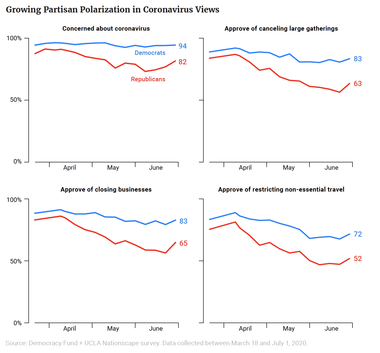
There have been drops in the percentage of Republicans who support limits on gatherings of 10 or more people (from 87 percent to 63 percent), who support closing businesses (from 86 percent to 65 percent), and who support restrictions on non-essential travel (from 81 percent to 52 percent).(8) There have been drops in support for these policies among Democrats as well, but those drops are not as steep. The uptick in concern in late June, especially among Republicans, has mitigated the partisan divide in attitudes about state and local policies slightly.
It is worth noting that the partisan differences between Democrats and Republicans have increased both in places with larger numbers of coronavirus infections and in places with fewer. For example, in the large central metropolitan areas that have seen the most cases, the partisan gap in concern about the coronavirus increased from six percentage points in March Nationscape surveys to 12 percentage points in June. There were similar eight- to ten-percentage-point increases in polarization in smaller metropolitan areas as well as more rural areas. The partisan gap in support for policies like travel restrictions also increased in many kinds of communities, including those harder hit by the virus as well as those less affected.(9)
The divergence in Democratic and Republican attitudes visible in Figure 5 again follows the rhetoric of key party leaders. President Trump and some Republican governors have pushed to “re-open” the country or individual states and argued that restrictions like closing certain businesses are no longer necessary. In some states, protestors mobilized in part by conservative groups have objected to these restrictions. Trump in turn validated these protests, saying that states like Michigan needed to be “liberated.” Democratic leaders in some states and cities have also begun taking steps to loosen restrictions, but in general they have been more cautious in doing so and more careful to emphasize concerns about public health.
A key piece of evidence suggests the importance of messages from party leaders. Political science research has long shown that the people most attentive to politics are the most likely to receive and absorb messages from their party’s leaders. Thus, when Democratic and Republican leaders disagree, as they increasingly do about the coronavirus, their divisions are most visible among those Democrats and Republicans in the public who are paying attention to politics.
Consider views of state and local restrictions on bans on large gatherings, which is a policy that continues to be particularly controversial. Among those who pay less attention to politics, the difference between Republicans and Democrats is modest and has increased only slightly in the most recent surveys (Figure 6). By contrast, among those paying more attention to politics, partisan polarization has increased by a larger amount. This is because politically attentive Republicans have shifted sharply against these restrictions. The decrease in support among politically attentive Republicans (28 percentage points, factoring in the increase in the most recent survey) is larger than that among less attentive Republicans (18 percentage points).(10) In contrast, there has been virtually no decrease among politically attentive Democrats, but a small decrease among less attentive Democrats. In other words, the most steadfast supporters of this restriction are politically attentive Democrats. The people whose support has fallen the most are politically attentive Republicans.
(8) These findings suggest that the partisan differences identified in earlier surveys may be larger now. For example, see: Shana Kushner Gadarian, Sara Wallace Goodman, and Thomas B. Pepinsky, “Partisanship, Health Behavior, and Policy Attitudes in the Early Stages of the COVID-19 Pandemic," 2020, Working Paper. Available at: https://papers.ssrn.com/sol3/papers.cfm?abstract_id=3562796.
(9) This is based on charting trends in the six types of communities in the National Center of Health Statistics’ urban-rural classification scheme. See: https://www.cdc.gov/nchs/data_access/urban_ rural.htm.
(10) Political attentiveness is measured by asking people factual questions about basic political rules and institutions. The Nationscape survey asks people two questions: the number of years in one full Senate term (six years), and who is the Chief Justice of the U.S. Supreme Court (where respondents must choose from a list including John Roberts, Sandra Day O’Connor, William Rehnquist, Paul Ryan, and Elena Kagan). On average, 39 percent of Nationscape respondents knew the answer to the first question and 43 percent to the second question. In Figure 6, the left-hand panel includes the 47 percent of respondents who got neither question correct. The right-hand panel includes the 29 percent of respondents who got both questions correct.
Figure 6
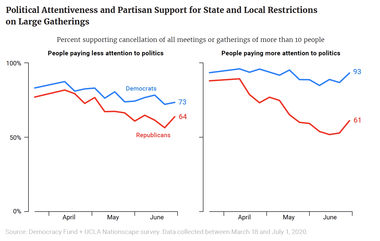
In short, politically attentive citizens most clearly reflect the signals they get from party leaders — and especially the growing divide on state and local restrictions intended to reduce coronavirus infections.
In a polarized climate, paying attention to politics appears to push Democrats and Republicans apart. Is there any factor that helps to bring them together? In fact, yes.
It is the emotion of disgust. Disgust sensitivity naturally orients people toward protective policies: People who are sensitive to disgust are especially likely to support policies that protect them and society from contamination. But politics can redirect some citizens away from these individual inclinations. For example, when political leaders advocate for fewer restrictions, such as weakening stay-at-home orders, their message is likely to resonate most among those who are less disgust-sensitive and thus not as predisposed to support such policies.
We find that exactly this pattern in coronavirus attitudes. Partisan divisions emerge among those who are less disgust-sensitive — either because messages from Democratic leaders make less disgust-sensitive Democrats more supportive of restrictive policies, or messages from some Republican leaders make less disgust-sensitive Republicans less supportive of these policies (or some combination of both). Given the data, we are unable to determine which possibility is more prevalent. Figure 7 depicts this pattern in both concern about the coronavirus and support for restrictions on travel.(11) We find a similar pattern in other attitudes as well, including support for other state and local policies.
(11) These results are based on statistical models that include party identification, disgust sensitivity, and the interaction between the two.
Figure 7
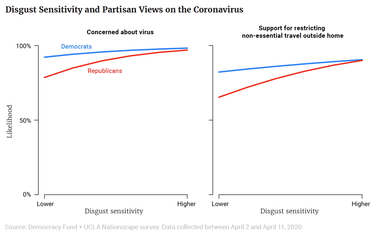
The Ebola, Zika, and coronavirus outbreaks have presented the United States with very different challenges to both the public health and political systems. The severity of the coronavirus pandemic is visible in the public’s greater concern about the outbreak, dissatisfaction with the federal government’s effort, and willingness to enact stringent border controls.
But despite the differences in these outbreaks, a common factor orients people’s views: the emotion of disgust. An aversion to contamination encourages people to engage in protective personal actions and to support protective public policies. During a public health threat, the evolutionary advantages of disgust sensitivity can accumulate for the collective good. Disgust may even help to overcome partisan divisions, which all but disappear among those who are most disgust-sensitive. But at the same time, disgust may also foment aversion to foreign peoples and a desire to police the country’s borders — even when the greater risk to public health comes from domestic transmission of the virus within the country’s borders. Disgust travels in the imagination as a surveillance system on overdrive.
These viral outbreaks also show that politics and political debate matter, above and beyond biological predispositions. When partisan leaders agree, they provide a powerful cue that elicits consensus from Americans and helps them pursue a collective purpose. When partisan elites disagree, this can fracture that collective consensus.
During the coronavirus pandemic, a lack of consensus is increasingly evident. As Republican and Democratic leaders have diverged on the proper course, so have Democrats and Republicans in the electorate — with Republicans becoming increasingly dubious about the value of the restrictions imposed by many state and local leaders. This is particularly true among Republicans who are paying the most attention to politics and thus most likely to receive party cues. At the same time, however, many Republicans — in fact, majorities — continue to support most of these restrictions.
The crucial question is how this interaction of biological and partisan predispositions plays out as the number of cases continues to increase and political leaders confront the question of whether to reinstate restrictions that they had previously eased. Americans will face renewed questions about which kinds of activities to engage in and how much risk they will tolerate to navigate the new normal. The decisions they make to shop, socialize, send their children back to school, worship, and the like must take into account the very real risk of infection.
It is likely that those already sensitive to contamination will be less willing to take those risks. The question for public health is how to message to those who are less sensitive to contamination to urge them to take preventative steps such as wearing masks in public. These individuals may instead respond to messages that harness different predispositions, such as a willingness to take action that protects or benefits others.(viii) However, one initial study found that such messages did not increase people’s willingness to wear a mask in public — and may have even backfired among conservatives.(ix) All of this speaks to the broader challenge of informing and influencing the public in a highly polarized political environment, where the actions of the public will materially affect the severity of the pandemic.
Subscribe to our mailing list for updates on new reports, survey data releases, and other upcoming events.